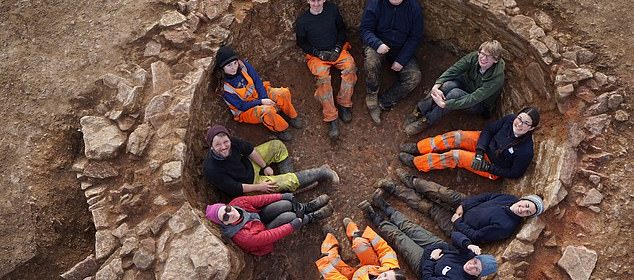Roman industrial site gives new picture of life in Roman Britain

Roman industrial site gives new picture of life in Roman Britain
Archaeologists discovered a Roman industrial complex that provides a detailed photo of what life was like in rural Britain under the Roman occupation.

Archaeologists in Corby Borough, Northamptonshire, made the rare find during an excavation in the Priors Hall Park housing development.
Two tile kilns, a large lime kiln for the production of mortar and five pottery kilns, along with large-scale stone and clay quarrying evidence, were found. The team behind the discovery say with further study it could shed fresh light on the town’s industrial history and what rural life was like in late Roman Britain.
Oxford Archaeology East recently completed a six-month excavation of a densely populated Late Romano-British industrial landscape to uncover the ruins.


The excavation was set within a Roman villa estate at Priors Hall in the town and it gives a detailed picture of the people who worked and lived in the area. The location of the site were uncovered in the final century of the Roman occupation, a time of economic and social turmoil within the empire.
The kilns and other discoveries were linked by a metal surface across the site that would have been used to facilitate the movement of materials required to construct and operate a large Roman villa about 984 feet to the east.
They also discovered a host of coins and intriguing artefacts such as animal bone, pottery and metal items, including jewellery and tools. The team say these items offer a rare insight into the lives of the estate workers as opposed to the villa owner, as other discoveries have shown.

A particular highlight is a coin of the rebel emperor Allectus, who reigned a small breakaway empire based in Britain in AD 293.
The coin was pierced with a single hole so it may be worn as a fashion item suggesting its value was beyond just monetary. A decorated complete buckle made of copper-alloy and depicting two flanking dolphins representing links with the gods of the sea, Neptune and Oceanus, found on the site, displays the fashion and taste of the time.
The organisation and finance required to build the villas – which were excavated on the site in the 1950s – would have been considerable.
The archaeology at Priors Hall shows evidence for numerous specialist tradespeople such as carpenters and builders, tile makers and mortar producers, perhaps being hired from nearby towns to make the pots, tiles, mortar and stone.

Nigel Wakefield, development director at Urban&Civic, which owns the site, said they’ve always known the site had a rich Roman history.
‘What we didn’t realise is quite how fascinating these new discoveries are, not only in terms of the buildings that were previously here but also in learning how they were constructed and understanding the materials and skills required to build them.
‘As master developers, it is important for us to uncover and preserve this history and we’re delighted with the role that Oxford Archaeology have played in this process.’
NCC County Archaeological Advisor Lesley-Ann Mather said this was part of an ongoing scheme of archaeological resource management on the Priors Hall site.
‘The previous archaeological evaluations within this area had identified that archaeological activity was present, however, the discovery of a Late Romano British industrial complex was entirely unexpected.’
The Roman villa complex that the newly discovered industrial area serviced is to be preserved in situ and left as grassland, Northamptonshire County Council said. ‘It will be covered by a heritage management plan which will protect and manage it in the long term,’ Mather said.


Oxford Archaeology East is now washing and cataloguing finds recovered from the site, ready to be sent for specialist analysis. Over 2000 villas are known from Roman Britain and over forty are known in Northamptonshire alone and although a large proportion have been excavated – the focus has been on the principal complex.
Less is known about the sourcing and manufacturing of materials to construct them and how they operated, and less still is known about the people who built them.
A large quantity of ceramic tiles were found, many of which had fingerprint impressions from the people who made them. A tile fragment included the partial inscription of the name of the maker, likely to be a name of one of the tilers themselves immortalised in clay.